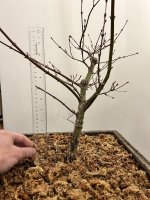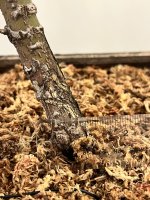Guy Smiley
Seedling
I have been reading Peter Adams book on Japanese Maples and would like to try the process he shows for developing trees.
Questions:
1) His first step is making a trunk chop at the location you want the first branch. My understanding is that he recommends making this chop in the spring at the same time as you would repot the tree. Will chopping the tree at this time cause a lot of sap loss?
2) When considering the 6:1 ratio for trunk size to hight, how big should I grow the trunk before making the first chop? I would like the finished tree to be around 16” tall. The trunk is currently 1”.
Here are some pictures of the tree that I am working with. I am planning to let it grow for at least another year to thicken the trunk. It is nice to see the bark starting to get some texture.


Questions:
1) His first step is making a trunk chop at the location you want the first branch. My understanding is that he recommends making this chop in the spring at the same time as you would repot the tree. Will chopping the tree at this time cause a lot of sap loss?
2) When considering the 6:1 ratio for trunk size to hight, how big should I grow the trunk before making the first chop? I would like the finished tree to be around 16” tall. The trunk is currently 1”.
Here are some pictures of the tree that I am working with. I am planning to let it grow for at least another year to thicken the trunk. It is nice to see the bark starting to get some texture.



